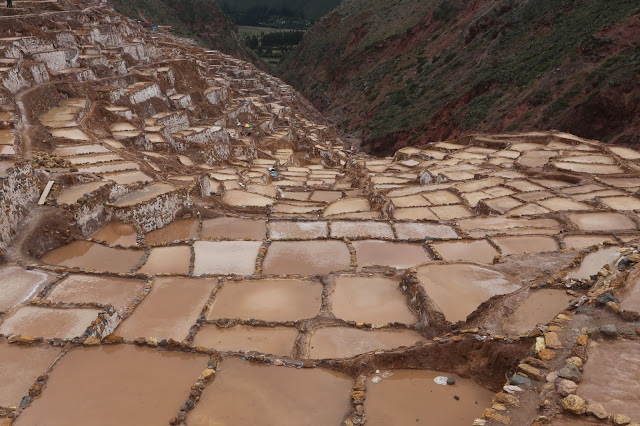The Sacred Valley of the Incas near Cusco is a major tourist destination in Peru. It was the heart of the Inca Empire and is full of interesting sights including many significant Inca ruins.
We did an all day tour of the valley and surrounding regions. After an early start, first stop was Lake Puray where Sam met some new friends.
Next stop was the town of Chinchero, a centre for traditional Inca weaving. A weaver showed us how they clean, spin and dye the alpaca wool. The dyeing was particularly interesting as we learned about the natural ingredients that went into making the many different colours used in woven pieces. The red dye (made by crushing a parasite that lives on the local cacti) was particularly vivid and is even used for lipstick. Elise and I brought a hand woven table runner to take home.
Following the weaver visit we went to see visit the historic Catholic church (Iglesia de Nuestra Senora de la Natividad) with some amazing frescoes (known as the Peru Sistine Chapel - alas photos not allowed) and nearby ruins. This was the high point of the tour at 3,800 meters and Elise in particular started feeling the altitude, although even climbing stairs was a bit of an effort for all of us.
Our next stop was at the fascinating circular Inca ruins at Moray which were used for agriculture. Crops grown on the different terraces were exposed to different temperatures which allowed the Incas to grow a diversity of crops in the same location. This site was believed to be a university for agriculture, attracting students from all the Inca cities and allowing research and acclimatisation of key crops to the coastal, jungle and alpine regions.
Near to Moray is a canyon filled with salt pans from which salt has been harvested since Inca times. Very saline water flows from the nearby mountain down the canyon where a series of channels and sluices divert the water into pans where the water evaporates leaving salt to be collected in the dry season. The pans are privately owned by a group of families who work the pans on a collective basis (plus they make money from the visiting tourists).

After a lunch stop we headed down the Urubumba river to Ollantaytambo. Above modern day Ollantaytambo the Incas built an amazing city and fortress cut into the mountain. We climbed the stairs beside the terraces to look at the interesting ruins and enjoy the views up the Urubumba valley
Finally in the late afternoon after a long drive we visited the ruins above Pisac. The terraces here were perhaps the most impressive yet, extending hundreds of meters down the steep mountainside which would have allowed for the cultivation of many different crops like coca, maize and potatoes all in the one area. The village occupied one side of a small hill jutting off the mountain above the terraces. As usual, the Incas had build a complex series of water channels from the glacier fed stream nearby to support the village and the farming terraces below. Given it was now late in the day there were fewer tourists around which made the visit more enjoyable than some of the other locations.
We arrived home in Cusco after dark, quite tired but pleased we had seen so much in one day.
We did an all day tour of the valley and surrounding regions. After an early start, first stop was Lake Puray where Sam met some new friends.
Next stop was the town of Chinchero, a centre for traditional Inca weaving. A weaver showed us how they clean, spin and dye the alpaca wool. The dyeing was particularly interesting as we learned about the natural ingredients that went into making the many different colours used in woven pieces. The red dye (made by crushing a parasite that lives on the local cacti) was particularly vivid and is even used for lipstick. Elise and I brought a hand woven table runner to take home.
| Red dye which can be further made into lighter and darker hues by adding other ingredients |
Following the weaver visit we went to see visit the historic Catholic church (Iglesia de Nuestra Senora de la Natividad) with some amazing frescoes (known as the Peru Sistine Chapel - alas photos not allowed) and nearby ruins. This was the high point of the tour at 3,800 meters and Elise in particular started feeling the altitude, although even climbing stairs was a bit of an effort for all of us.
| Chinchero high in the hills |
After a lunch stop we headed down the Urubumba river to Ollantaytambo. Above modern day Ollantaytambo the Incas built an amazing city and fortress cut into the mountain. We climbed the stairs beside the terraces to look at the interesting ruins and enjoy the views up the Urubumba valley
Finally in the late afternoon after a long drive we visited the ruins above Pisac. The terraces here were perhaps the most impressive yet, extending hundreds of meters down the steep mountainside which would have allowed for the cultivation of many different crops like coca, maize and potatoes all in the one area. The village occupied one side of a small hill jutting off the mountain above the terraces. As usual, the Incas had build a complex series of water channels from the glacier fed stream nearby to support the village and the farming terraces below. Given it was now late in the day there were fewer tourists around which made the visit more enjoyable than some of the other locations.
We arrived home in Cusco after dark, quite tired but pleased we had seen so much in one day.
Comments
Post a Comment